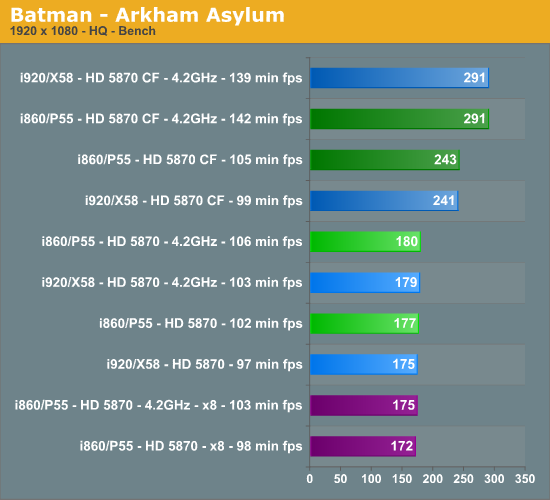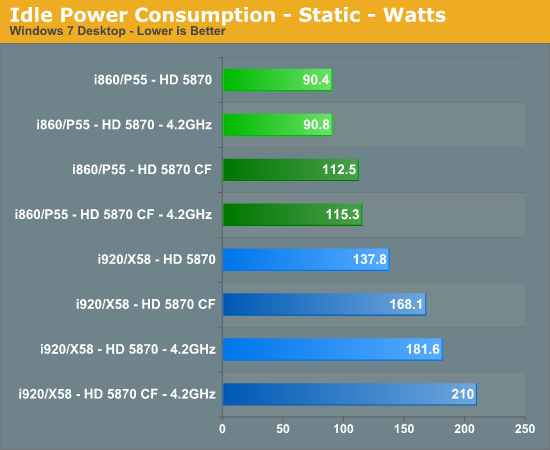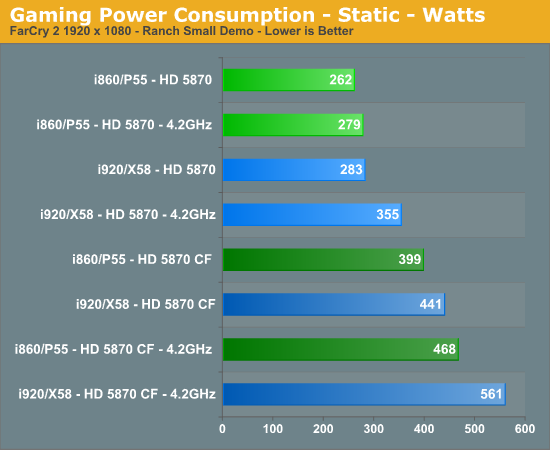ATI HD 5870 Scaling Performance: X58 vs P55 Showdown
by Gary Key on September 29, 2009 12:00 PM EST- Posted in
- Motherboards
One of our favorite new games is Batman - Arkham Asylum. We set all options as high as they will go and utilize the games built-in benchmark for our results. Both platforms are just stupid fast when running this game.

The single card results at x8 trails the x16 results by about 1% at stock and 3% when overclocked. Minimum frame rates for the x16 single card results are around 5% better on the P55 platform at stock and 3% when overclocked.
Batman – Arkham Asylum CrossFire Scaling – Average Frame Rates
| ATI HD 5870 CF Scaling | Batman – Arkham Asylum | Batman – Arkham Asylum 4.2GHz |
| Intel Core i7 920 (X58) | 37.7% | 62.6% |
| Intel Core i7 860 (P55) | 37.3% | 61.7% |
At stock and overclocked speeds, both platforms are practically tied when it comes to scaling in average frame rates.
Batman – Arkham Asylum CrossFire Scaling – Minimum Frame Rates
| ATI HD 5870 CF Scaling | Batman – Arkham Asylum | Batman – Arkham Asylum 4.2GHz |
| Intel Core i7 920 (X58) | 2.1% | 34.9% |
| Intel Core i7 860 (P55) | 7.1% | 33.9% |
Minimum frame rates favor the P55 by 6% and scaling favors the P55 by 5% in our stock results, while the X58 is slightly ahead in the overclocking test.
Power Consumption
Both systems have all power management features enabled and we utilize the Balanced Power option in Windows 7. Our 4.2GHz overclock setting has the Core i7 860 VCore offset option enabled with an ending voltage of 1.3875V. VTT is set to 1.310V, CPU PLL at 1.80V, and VDimm at 1.62V. The Core i7 920 offset is enabled for a final VCore reading of 1.335V. VTT is set to 1.375V, CPU PLL at 1.86V, and VDimm at 1.65V.

Idle power is Lynnfield's biggest ally and the Radeon HD 5870 plays well here. Even overclocked to 4.2GHz with a pair of 5870s, Lynnfield uses less power than a single 5870 on an i7 920. Bloomfield runs at a 12x multiplier at idle while Lynnfield runs at 9x. Bloomfield also likes to ramp up VTT voltage in a hurry compared to Lynnfield, the result is nearly zero impact at idle power consumption but when Bloomfield is overclocked, the platform just consumes more power thanks to additional circuitry.

Under load, once again, there's virtually no impact from CPU overclocking on Lynnfield compared to Bloomfield. At stock frequencies however, the GPU power dominates and thus there's less than a 10% power difference between X58 and P55.










85 Comments
View All Comments
GeorgeH - Tuesday, September 29, 2009 - link
Wow, you're totally right:Lynnfield: 12-28 min FPS
X58: 8-26 min FPS
Talk about a crippled platform!
We all already know that you're a moron, but in the future please try to make it less obvious. Thanks.
philosofool - Tuesday, September 29, 2009 - link
The result of this test is really clear to me: if you are even remotely close to on a budget, P55 w/ a great card is the way to go. The $100 you save on a P55 mobo invested into graphics will get you way more than the same invested in X58 and a $100 cheaper graphics card. If money is no object, get X58. Perhaps more importantly, once we're dealing with cards and games that drop things well below the 60Hz refresh rate of our monitor, the additional bandwidth in X58 will probably make an even smaller difference.The fears regarding the integrated PCIe controller on Lynnfield are wildly exaggerated.
strikeback03 - Wednesday, September 30, 2009 - link
I'd say a $100 difference in motherboards is largely an exaggeration depending on exactly what features you are looking for, the power consumption differences are far more interesting to me.Now if we could only find out whether 8x PCIe would be a bottleneck for a SATA3 card.
UNHchabo - Wednesday, September 30, 2009 - link
In terms of theoretical bandwidth, there's plenty in a PCIe slot. The SATA 6Gbps standard gives about 600MB/s of effective bandwidth, and PCIe 2.0 has 500MB/s per lane. This means that with PCIe 2.0, your motherboard slot is only limiting your card's performance if you give one lane per port.yacoub - Tuesday, September 29, 2009 - link
Sure, and the power consumption savings are a nice plus. Then consider that 90+% of us don't even care about CF/SLI because we only ever one run GPU card, and there's really no reason to bother with X58 over P55.ekoostik - Tuesday, September 29, 2009 - link
Agreed. Really enjoyed reading this on my new single-GPU powered 860 sitting silently next to me.yacoub - Tuesday, September 29, 2009 - link
"Does that mean the integrated dual x8 PCIe 2.0 logic on Lynnfield is a poor choice compared to the dual x16 PCIe 2.0 sporting X58, absolutely not based on our initial tests."The comma after "X58" should be a question mark and "absolutely" should be the beginning of a new sentence. ;)
the zorro - Tuesday, September 29, 2009 - link
almost 10% penalty because of the lynnfield crippled northbridge.its not just that but in the more interesting part of the game when there is more congestion, lynnfield stutters.
if you are going to buy a new spanking 3.72 tflops directx ati card don't commit the mistake of using lynnfield.
Griswold - Monday, October 5, 2009 - link
You're an idiot regardless of what you buy - so it evens out.DominionSeraph - Wednesday, September 30, 2009 - link
"x58 is 1fps faster than lynnfield!!" as he sits behind his 33ms input lag, 3 frame ghosting, 60Hz LCD using a 600dpi mouse on a free mousepad.